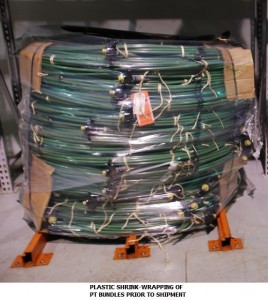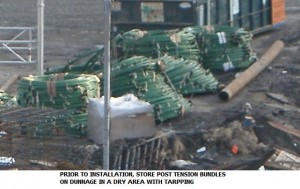Lately, a lot of focus has been given to the technical aspects of unbonded post-tensioning systems. At times, however, the construction team must not forget the basic performance issues involved with post tensioning. In particular, the proper protection of unbonded post-tensioning tendons is fundamental to prevent corrosion.
POST TENSIONING SUPPLIER
While the protection of tendons is mostly under the control of the jobsite, the PT supplier must be involved from the beginning. It starts with preventing the steel raw material and finished products from being exposed to corrosive elements (rain, snow, de-icing chemicals, salt-spray, etc.) The exposure to these corrosive elements will greatly depend on where the Extrusion and Fabrication plants are located. Ideally, the post tensioning tendons should be stored indoors in a climate-controlled warehouse.
Additionally, it is more beneficial to have the Extrusion and Fabrication plants under the same roof. This minimizes the products exposure to elements during transportation. It is a good idea to ask your PT supplier how their operations are set up and to visit the plants.

SHIPPING
Once the PT material is ready to ship, the PT supplier will typically use a flat-bed truck due to heavy-trucking requirements. The question is whether to “shrink-wrap the encapsulated tendon bundles” and “tarp/cover the truck.” The best Structural Engineering specifications incorporate both of these items. Both are cheap insurance to minimize corrosion in the long run since it is hard to control the weather during shipping.
JOBSITE STORAGE
Finally, the material arrives at the jobsite. During our jobsite visits, we have seen our shrink-wrapped PT bundles and boxes of PT material sitting in a pile of mud and water. This is not good. Again, the best Engineering specifications require that the post-tensioning material be stored as follows: 1) Stored on elevated dunnage in a dry-area, 2) Tarpped in a tent-like fashion to allow air to circulate, 3) Maintain shrink-wrapping until installation, 4) Long-term storage issues should be addressed.
The PT material includes tendons, loose anchors, wedges, miscellaneous accessories and the stressing equipment.

JOBSITE INSTALLATION
Protection must continue ever after the tendons are installed on the deck. Some of the better Engineering specifications require “temporary protection for exposed strands/anchors at construction joints.” The tendon system will be exposed for around 2-3 days until the concrete is poured and reaches the required strength for stressing. On parking garages, this is very important if the ramp slopes downhill into the anchor cavity (i.e. the next pour is above the first pour). Rain, mud and dirt all travel downhill and get lodged into the anchor cavity. This debris will affect the seating of the wedges during stressing.

Another item that needs attention from the jobsite personnel is cutting and capping the tendon tails. The tendon tails should be cut and capped soon after the Engineer gives the approval. If anchor cavities can be grouted shortly thereafter, then the steel will have less exposure to corrosive elements. At times, we have noticed that tendon tails have not been cut or capped on the lower levels, but construction is almost complete on the upper levels. Granted, this method is a labor-saver for the contractor but it puts the whole PT system at risk.
– Rattan Khosa, AMSYSCO
– Neel Khosa, AMSYSCO
Copyright © 2009 by AMSYSCO, Inc. All rights reserved.













